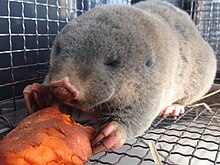| Zokors Temporal range: Late Miocene - recent
| |
|---|---|

| |
| Plateau zokor, (Eospalax fontanierii baileyi) | |
| Scientific classification | |
| Domain: | Eukaryota |
| Kingdom: | Animalia |
| Phylum: | Chordata |
| Class: | Mammalia |
| Order: | Rodentia |
| Family: | Spalacidae |
| Subfamily: | Myospalacinae Lilljeborg, 1866 |
| Genera | |
Zokors are Asiatic burrowing rodents resembling mole-rats. They include two genera: Myospalax and Eospalax. Zokors are native to much of China, Kazakhstan, and Siberian Russia.
Traditionally, zokors were thought to be closely related to either hamsters (Cricetinae) or voles (Arvicolinae), but recent molecular phylogenetic studies have demonstrated they are more closely related to blind mole-rats (Spalacinae) and root and bamboo rats (Rhizomyinae) in the family Spalacidae. It appears that one of the first important evolutionary splits in muroid rodents is between burrowing forms and nonburrowing forms.[citation needed]
Unlike the other spalacids, which primarily use their incisors, zokors use their powerful front claws for digging. They have small eyes and no external ears. Zokors feed on plant matter such as tubers and seeds.
Zokor bone is sometimes used as a more environmentally friendly alternative to tiger bone in traditional Chinese medicine. This product is called sailonggu.[citation needed]